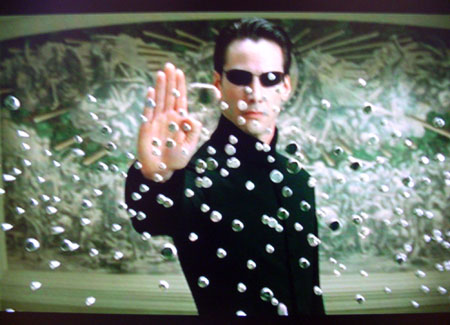The 20" LCD Shootout: Dell versus Apple
by Kristopher Kubicki on April 27, 2005 12:05 AM EST- Posted in
- Displays
Application Analysis
The core of our LCD benchmarking comes from real application analysis. We play with a lot of monitors and it gets easier for us each time to pick out problems with an LCD just by using the right application. Here are a few quick looks at some demanding full screen applications. We already ran ColorVision's OptiCal software, so all of our monitors are calibrated and adjusted to the same curves.High Definition Video – We played the WMV9 1080p and 720p versions of “Under Sea Adventure” to give our monitor a little taste of high definition video. In many of our previous analyses, we simply ran WMV9 content unscaled to test color depth and clarity. However, since both the Apple Cinema and Dell 2005FPW are capable of widescreen unscaled aspect ratios (at least for 720p), we thought it best to put both of these monitors completely through their paces. No surprise, but there doesn’t seem to be any corruption or shifts in any of the colors. However, keep in mind that neither of these displays supports HDCP! We could not watch 1080i or 720p signals on either display from a regular Comcast HD receiver, since neither display has a DVI-HDCP input. While pin compatible, any HDCP source simply terminates after a few seconds of video. The Dell 2005FPW has a few additional inputs, so we can actually use a component-to-VGA (15-pin D-sub) cable and watch HD content in this manner. Of course, for the same reason why we don’t encourage anyone to use 15-pin D-sub cables for regular computer use, we really don’t recommend D-sub for TV either if it can be avoided. Unfortunately, in this scenario, it cannot.
The Matrix Reload, The Matrix - We use the Matrix series to test full motion video on our LCDs. Since the Matrix isn't the best movie to test color reproduction, we typically only look for motion blur on gray-to-gray transitions or other imperfections in the signal. Both displays demonstrated accurate sharpness, although we noticed that the slightly duller Apple display had more of a “washed out” look to it in comparison to the Dell 2005FPW. Typically, we only see this on brighter LCDs with lower contrast ratios. Since the Apple 2005FPW has a (very) slight lower measured contrast ratio, this didn’t surprise us during out testing.
World of Warcraft – Although I didn’t personally start playing World of Warcraft until Anand published his Performance Guide, WOW happens to be one of the most perfect games to test LCD gaming. The fairly rich color palette, high motion objects and often contrasting lights and darks make the game a perfect haven to really put a display to its limits. (Unfortunately, once you turn it on, it also becomes nearly impossible to stop playing and start writing). Putting our displays into mirroring mode and playing for a few hours really stresses the importance of good color calibration in game settings; for example, it became almost impossible to differentiate portions of the grass needed to be selected for a quest on both LCDs before calibration through ColorVision’s OptiCal. Because both monitors were using DVI connectors, these changes had to be made to the color curves on the PC because the functionality is disabled on the monitors.
Max Payne 2 - The extreme light and dark transitions in Max Payne still provide us with the sufficient criteria to benchmark transient response time; specifically, we can focus on the light and dark extremes. We detected no red shift (as we usually do on this game for PVA displays), and had no problem with motion blur.
Photoshop CS – We typically don’t mention applications like Photoshop, but while using some of our new found desktop space, we took to advanced features in Photoshop like a fish in water. It’s no surprise that high end graphics (and, of course, video) are done on these displays; the higher resolution and wider room allow us to spread the tool bars out further while giving us more room to work. Widescreen displays feel awkward at first, but given hours of tinkering and readjusting, the additional room feels almost necessary.













70 Comments
View All Comments
intellon - Wednesday, April 27, 2005 - link
Oh why oh why did you leave out a small paragraph of comment on the composite input or the s-video one... If you can update the review by connecting xbox to it and playing halo on the xbox, and commenting on the playability in just one itsy bitsy paragraph that would make this head to head review complete...Lots of students with cramped space dream about using computer monitor as a display for their consoles.
jasonsRX7 - Wednesday, April 27, 2005 - link
Lots of Mac users love the Dell widescreen displays, they're great for the money. I'm a Mac user and I thought a lot about getting a Dell widescreen but ended up with a 30" Apple Cinema display instead. There are tons of people in the Mac forums I visit that use the Dell 20" and 24" monitors, though.Chuckles - Wednesday, April 27, 2005 - link
Hey #11: Try $799.http://store.apple.com/1-800-MY-APPLE/WebObjects/A...
#13:
As long as your video card has the S-Video Port between the DVI ports, two connectors will fit. If they are crammed next to each other, they won't.
xsilver - Wednesday, April 27, 2005 - link
"The largest mistake that we see people make when they buy a new LCD is to put their new, bright LCD in a dim, dark room (and then turn the LCD down to 25% brightness). Not only is this terrible for your eyes,"can you clarify this? why is this so bad? you mention colour offset, but if this is changed accordingly, what is different?
lebe0024 - Wednesday, April 27, 2005 - link
This has nothing to do with MAC vs. PC. This is a display manufactured by Apple, which has nothing to do with Apple's "Macintosh" computer line, other than the fact that they're sold together.MIDIman - Wednesday, April 27, 2005 - link
An absolutely superb real down to earth mac vs. pc comparison.Reminds me of the millions of times I've been confronted by mac-lovers saying that the Apple Cinema Display is the only good LCD on the market and is "worth" the extra cost. Nowadays, I just send them to anandtech!
hirschma - Wednesday, April 27, 2005 - link
A couple of quick comments:* I have two OLD Apple DVI monitors hooked to my PC. While they work great, there is no software for the PC to control anything except the backlight controls, like the model reviewed here. I'm guessing that the new model still doesn't come with anything in that regard.
* The Apple DVI cable head looks too "fat" to use with Dual DVI cards - looks like one port will be partially blocked. Is that accurate?
I'd like to have heard more about the Apple monitor's suitability for use with Windows.
JH
cHodAXUK - Wednesday, April 27, 2005 - link
Dell UK are charging nearly £600 for the 2005, thats $1000 the cheeky mofos. Looks like Dell are another company exploiting the ripoff Britian mentality.DCstewieG - Wednesday, April 27, 2005 - link
I'm surprised the price of the Apple display is never mentioned. If the Dell is $486 at the outlet store online you figure the Apple name will cost maybe $100 or so more? So about $600.Try $999.
Geez, I think that thing is as sexy as anyone else, but holy crap is that a premium. And without the possibility of analog! $350 for the Dell on the right day makes a hell of a lot more sense to me, even if roles were reversed and it had been rated slightly worse than the Apple.
DeanO - Wednesday, April 27, 2005 - link
Good review Kristopher :)Personally, I've seen photos that show some serious backlight leakage on these things, so I'm still a little hesitant, though it's reassuring that you guys haven't had this problem.
Hope the upcoming reviews of bigger screens include the Dell 2405FPW. That screen looks fantastic!